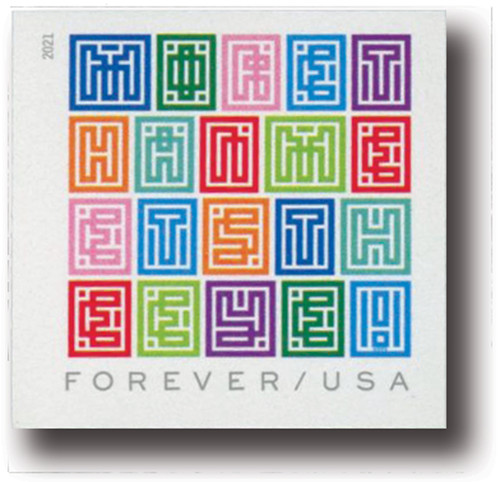
# 5614a - 2021 First-Class Forever Stamp - Imperforate Mystery Message
US #5614a
2021 Mystery Message (Imperforate)
• Design includes a hidden message
Stamp Category: Commemorative
Value: 55¢ First Class Mail Rate (Forever)
First Day of Issue: July 14, 2021
First Day City: Washington, DC
Quantity Issued: 20,000,000 (Includes die-cut AND imperforate stamps. The exact quantity of imperforate stamps is unknown, but it is only a tiny fraction of the total print quantity, making the imperforates much scarcer than traditional die-cut stamps.)
Printed by: Banknote Corporation of America
Printing Method: Offset, Microprint
Format: Panes of 20
Tagging: Phosphor, Block Tag
Why the stamp was issued: To give stamp users and collectors a fun visual puzzle to solve. Especially appeals to young children, encouraging them to take interest in stamps.
About the stamp design: Includes bright colors and interesting shapes. Every colorful square includes a letter in an unusual pattern. The patterns appear random at first, but when you look closely, you can see the message reads “MORE THAN MEETS THE EYE!” Designed by Antonio Alcalá.
First Day City: First Day of Issue Ceremony held at the International Spy Museum in Washington, DC.
History the stamp represents: In the 1800s, the arrival of a letter was an exciting event for the whole household. Letters were rarely kept private, so couples found ways to convey secret messages – by using stamps.
The language of stamps was developed in the early days of stamped mail, when recipients paid for the letters they received. To avoid paying the postage, the sender would place the stamp at an angle or in a different place on the envelope. This placement conveyed such messages as “yes,” “no,” or “come at once.” The recipient could then refuse the letter, having received the message through the stamp’s placement.
Once postal rates dropped and senders began paying postage, they used stamps to relay personal messages. Soon, postcard companies printed guides for deciphering the language of stamps. The messages became more complex, such as “Take care, we’re being watched,” “I have discovered your deceit,” and “May I ask for your portrait?” One guide claimed to have 270,000 different messages for stamp placement. Despite the widespread use and printed guides, there was never one universal code. It was possible codes could be misinterpreted and hearts broken.
Eventually, postal administrations began requiring stamps to be placed in the top right corner, bringing an end to this whimsical era of stamp language.
US #5614a
2021 Mystery Message (Imperforate)
• Design includes a hidden message
Stamp Category: Commemorative
Value: 55¢ First Class Mail Rate (Forever)
First Day of Issue: July 14, 2021
First Day City: Washington, DC
Quantity Issued: 20,000,000 (Includes die-cut AND imperforate stamps. The exact quantity of imperforate stamps is unknown, but it is only a tiny fraction of the total print quantity, making the imperforates much scarcer than traditional die-cut stamps.)
Printed by: Banknote Corporation of America
Printing Method: Offset, Microprint
Format: Panes of 20
Tagging: Phosphor, Block Tag
Why the stamp was issued: To give stamp users and collectors a fun visual puzzle to solve. Especially appeals to young children, encouraging them to take interest in stamps.
About the stamp design: Includes bright colors and interesting shapes. Every colorful square includes a letter in an unusual pattern. The patterns appear random at first, but when you look closely, you can see the message reads “MORE THAN MEETS THE EYE!” Designed by Antonio Alcalá.
First Day City: First Day of Issue Ceremony held at the International Spy Museum in Washington, DC.
History the stamp represents: In the 1800s, the arrival of a letter was an exciting event for the whole household. Letters were rarely kept private, so couples found ways to convey secret messages – by using stamps.
The language of stamps was developed in the early days of stamped mail, when recipients paid for the letters they received. To avoid paying the postage, the sender would place the stamp at an angle or in a different place on the envelope. This placement conveyed such messages as “yes,” “no,” or “come at once.” The recipient could then refuse the letter, having received the message through the stamp’s placement.
Once postal rates dropped and senders began paying postage, they used stamps to relay personal messages. Soon, postcard companies printed guides for deciphering the language of stamps. The messages became more complex, such as “Take care, we’re being watched,” “I have discovered your deceit,” and “May I ask for your portrait?” One guide claimed to have 270,000 different messages for stamp placement. Despite the widespread use and printed guides, there was never one universal code. It was possible codes could be misinterpreted and hearts broken.
Eventually, postal administrations began requiring stamps to be placed in the top right corner, bringing an end to this whimsical era of stamp language.











